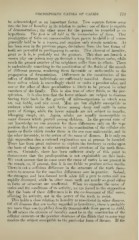Page 763 - My FlipBook
P. 763
PREDISPOSING CAUSES OF CARIES. 773
be acknowledged as an important factor. Two separate factors enter
int(j the law of heredity in its relation to caries : one of these is capable
of demonstration ; the other must for the present be regarded as an
hypothesis. The first is all told in the transmission of form. That
peculiarities of form are transmissible from parent to child is of course
generally held to be a truism, and requires only simple mention. As
has been seen in the previous pages, deviations from the best forms of
teeth are powerful in predisposing to caries. This element of heredity,
great as it is, is probably not the greatest. This does not furnish a
reason why one person may go through a long life without caries, \y\\\\e
much the greater number of his neighbors suffer from its effects. There
is undoubtedly something in the constitution of the fluids of the mouth
of different persons rendering them favorable or unfavorable to the
propagation of fermentation. Differences in the constitution of the
saliva of different individuals are sufficiently manifest. Some persons
have saliva which is exceedingly viscid or emits a peculiar odor, and
one or the other of these peculiarities is likely to be present in other
members of the family. This is also true of other fluids, as the per-
spiration. It is also true that the lower animals are subject to diseases
having their basis in the growth of micro-organisms to which men
are not liable, and vice versa. Men are but slightly susceptible to
anthrax, which makes such havoc among sheep and cattle in some
parts of Europe, while the lower animals are not subject to measles,
whooping cough, etc. Again, adults are usually insusceptible to
many diseases which prevail among children. In the present state of
our knowledge we can account for these differences only on the sup-
position that there are variations in the constitution of the cellular ele-
ments or fluids which render them in the one case unfavorable, and in
the other favorable, to the action of the cause of disease. It is only on
this supposition that a rational explanation can at present be founded.
There has been great endeavor to explain the tendency to caries upon
the basis of changes in the nutrition and structure of the teeth them-
selves. Certainly, there has been sufficient study of this point to
demonstrate that the predisposition is not explainable on this basis.
We must assume that in some cases the cause of caries is not present in
the mouth, or, if present, that it is too feeble to produce active results.
There is not a sufficient difference in the structure of the teeth them-
selves to account for the manifest differences seen in practice. Indeed,
the strongest and best-formed teeth often fall a prey to caries and are
rapidly destroyed, while in other cases teeth not nearly so good either
in form or structure are unaffected. When we examine the cause of
caries and the conditions of its activity, we are forced to the supposition
that the basis of these differences is in the environment of that cause,
affecting its activity, not in the power of the teeth to resist.
This holds a close relation to heredity as manifested in other diseases.
Of all diseases that are to-day regarded as hereditary, there is probably
not more than one (syphilis) directly transmissible from parent to child.
In all others the element of heredity must be in the constitution of the
cellular elements or the peculiar character of the fluids that in some way
renders the subject susceptible to the particular form of disease. If the


